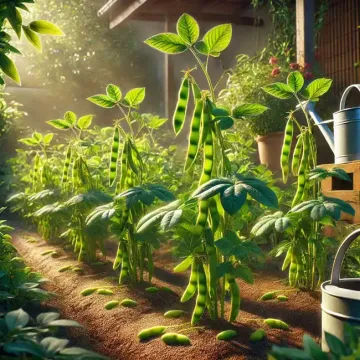Introduction to Edamame
Edamame (Glycine max), also known as green soybeans, has been a staple in East Asian cuisine for centuries. In recent years, it has gained popularity worldwide due to its nutritional benefits, including being an excellent source of protein, fiber, and essential vitamins and minerals. Edamame is often eaten as a snack, appetizer, or added to salads and stir-fries.
Choosing the Right Variety
When selecting edamame varieties for your garden, look for those specifically bred for home gardeners. Common varieties include:
- ‘Midori Giant’: Known for its large, flavorful pods.
- ‘Butterbean’: A smaller variety with a buttery taste.
- ‘Envy’: An early-maturing variety, great for regions with shorter growing seasons.
Make sure to choose non-GMO, organic seeds if that aligns with your gardening preferences.
Planting Edamame
Edamame is a warm-season crop, thriving in temperatures between 70°F and 85°F (21°C to 29°C). It requires a full-sun location with well-draining soil.
- When to Plant: Plant edamame seeds in the garden after the last frost date when the soil temperature has reached at least 60°F (16°C). In colder climates, you may want to start the seeds indoors and transplant them once the soil warms up.
- Soil Preparation: Edamame grows best in loose, fertile soil with a pH between 6.0 and 7.0. Amend your garden bed with compost or well-rotted manure to improve soil structure and fertility. Avoid using nitrogen-rich fertilizers, as soybeans are legumes that fix their nitrogen.
- Spacing: Plant seeds 1 inch deep and space them 3 inches apart in rows spaced 18 to 24 inches apart. Thin seedlings to 6 inches apart once they emerge.
Caring for Edamame Plants
Edamame is relatively low-maintenance, but proper care is essential for a good yield.
- Watering: Keep the soil consistently moist, especially during flowering and pod development. However, avoid overwatering, as waterlogged soil can lead to root rot. Drip irrigation or soaker hoses work well to provide even moisture.
- Weeding: Keep the garden bed free of weeds, especially in the early stages when the seedlings are still small. Mulching can help suppress weeds and retain soil moisture.
- Pest and Disease Control: Edamame is generally resistant to many pests and diseases. However, aphids, spider mites, and Japanese beetles can sometimes be an issue. Use insecticidal soap or neem oil as needed. Rotate crops yearly to minimize disease risks.
Harvesting Edamame
Harvesting edamame at the right time ensures maximum flavor and nutrition.
- When to Harvest: Edamame pods are ready to harvest when they are plump and bright green, typically about 70 to 90 days after planting. The pods should feel firm to the touch, and the beans inside should fill the pod but not yet begin to harden. Avoid waiting too long, as the beans will lose their tenderness and sweetness.
- How to Harvest: Use scissors or garden shears to cut the pods from the plant, or pull the entire plant and harvest the pods. Be gentle to avoid damaging the plants, especially if you plan to harvest more later.
Post-Harvest Care and Storage
- Storing Edamame: Edamame is best enjoyed fresh, but if you need to store it, blanch the pods in boiling water for 2 to 3 minutes, then cool them quickly in ice water. Freeze the blanched edamame in an airtight container for up to six months.
- Using Edamame: Simply boil or steam the pods for 4 to 5 minutes and sprinkle them with salt for a delicious snack. Edamame can also be shelled and added to soups, salads, stir-fries, and other dishes.
Growing edamame in your home garden is a fantastic way to enjoy this nutrient-rich legume while gaining the satisfaction of cultivating your own food. With the right care and attention, your edamame plants will produce a bountiful harvest, perfect for snacking or adding to your favorite dishes. Whether you’re an experienced gardener or a beginner, edamame is a rewarding and versatile crop to add to your garden lineup.

